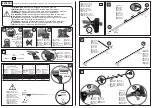
AMER-EN-TM-ODY July 2021
www.odysseybattery.com
D. BATTERY LIFE EXPECATIONS
Cycling Applications and Depth of Discharge (DOD)
Applications in which the battery is frequently discharged and recharged are called cyclic. A complete
cycle starts with a charged battery that is discharged and then brought back to a full charge. Design
battery life in these applications is stated as the number of cycles the battery will deliver before its
capacity drops to 80% of its rated value. For example, suppose a battery is rated at 100 amp-hours
(Ah) and has a published cycle life of 400. This means that the battery can be cycled 400 times before
its delivered capacity drops to 80Ah.
DOD is one of the main factors that determines how many cycles a battery can provide. The DOD is
simply the ratio of capacity extracted from the battery to its rated capacity expressed as a percentage.
If a 100Ah battery delivers 65Ah and is then recharged, it is said to have delivered a 65% DOD cycle.
The general relationship between DOD and number of cycles is shown below in Figure 1. Higher DODs
results in longer cycle life.
E . FLOAT APPLICATIONS
Batteries that are primarily used as a source of backup or emergency power are not frequently cycled.
The life of these types of applications is referred to as float life. Emergency lighting, security alarms
and Uninterruptible Power Systems (UPS) are good examples of batteries in float applications. In each
of these applications the battery is discharged only if the main utility power is lost; otherwise the bat-
tery remains on continuous float or trickle charge.
Since ODYSSEY
®
AGM
2
batteries are dual purpose by design, they offer a long-life battery option in
float applications. At room temperature (77°F (25°C), these batteries have a design life of 10+ years in
float applications. At end of life, an AGM
2
battery will still deliver 80% of its rated capacity.
F.
CHARGING
The relationship between cycle life and DOD shown in Figure 1 holds only if the battery is properly
charged after each discharge. This means that each time the battery is discharged, between 103-
105% of the discharged amp hours (Ah) should be returned. For example, if 100Ah were discharged
from the battery between 103-105Ah must be returned to the battery for a full recharge. Failure to do
so (over or under charging) will result in a loss of cycle life and ultimately a loss of capacity. There are
*Data based on laboratory testing
Figure 1
9
Summary of Contents for NSB-AGM
Page 1: ...AGM2 Technical Manual...


































